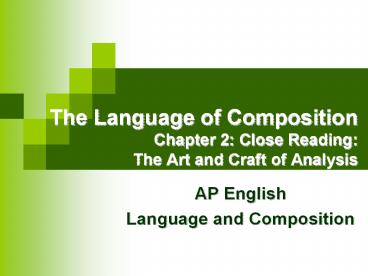The Language of Composition Chapter 2: Close Reading: The Art and Craft of Analysis - PowerPoint PPT Presentation
Title:
The Language of Composition Chapter 2: Close Reading: The Art and Craft of Analysis
Description:
The Language of Composition Chapter 2: Close Reading: The Art and Craft of Analysis AP English Language and Composition Close Reading Close Reading is the process of ... – PowerPoint PPT presentation
Number of Views:1848
Avg rating:3.0/5.0
Title: The Language of Composition Chapter 2: Close Reading: The Art and Craft of Analysis
1
The Language of CompositionChapter 2 Close
Reading The Art and Craft of Analysis
- AP English
- Language and Composition
2
Close Reading
- Close Reading is the process of analyzing a text
at the diction level to develop a greater
understanding. - Deeper understanding is derived from the
connotative meanings of these words.
3
Close Reading
- Writing about close reading reverses this
process, starting with the deeper understanding
and then supporting that understanding by
addressing the smaller details, via the words
used.
4
Close Reading
- Close reading is an instinctive process that we
undertake daily. - In a personal conversation, we always ask
ourselves - Whats his purpose?
- Whats she after?
5
Close Reading
- We take into account the context of the
situation. - Has anything significant just happened to prompt
the conversation?
6
Close Reading
- We take into account more subtle elements
- Body language
- Facial Expressions
- Gestures
- Tone of Voice
7
Close Reading
- Close Reading requires a return to the Rhetorical
Triangle. - These elements help establish Ethos, Logos, and
Pathos with the audience.
8
Analysis of Style
- Understanding style provides insight into the
choices the author makes at the diction and
syntax levels.
9
Analysis of Style
- Style is the authors use of tone, sentence
structure, and vocabulary. - Style can be divided into two categories
- Tropes use of diction.
- Schemes use of syntax.
10
Key Questions for the Analysis of Diction
- 1. Which of the important words in the passage
(verbs, nouns, adjectives, and adverbs) are
general and abstract? Which are specific and
concrete?
11
Key Questions for the Analysis of Diction
- 2. Are the important words formal, informal,
colloquial, or slang? - 3. Are some words non-literal or figurative,
creating figures of speech such as metaphors?
12
Key Questions for the Analysis of Syntax
- 1. What is the order for the parts of the
sentence? Is it the usual (subject-verb-object),
or is it inverted?
13
Key Questions for the Analysis of Syntax
- 2. Which part of speech is more prominent nouns
or verbs?
14
Key Questions for the Analysis of Syntax
- 3. What are the sentences like?
- Are they periodic (moving toward something
important), or - Are they cumulative (adding details that support
an important idea in the beginning of the
sentence)?
15
Key Questions for the Analysis of Syntax
- 4. How does the sentence connect its words,
phrases, and clauses?
16
Rhetorical Analysis
- Rhetorical analysis is understanding how the
author connects the speaker, subject, and
audience, and why the author makes the stylistic
choices he/she makes.
17
Rhetorical Analysis
- Close reading is about identifying techniques and
strategies (diction and syntactical choices), but
it is also about understanding how these choices
help to achieve the authors overall purpose.
18
(No Transcript)
19
(No Transcript)
20
(No Transcript)
21
Rhetorical Analysis
- Analysis is about answering the so what
question.
22
Rhetorical Analysis
- As an analyst, you must
- 1. Determine the authors purpose
23
Rhetorical Analysis
- 2. Identify the authors rhetorical choices
- 3. Explain the effect the authors choices have
on the meaning of the text
24
Types of Close Reading
- Annotation is a process of note taking in the
text or on post-it notes in the margin of the
text. - Its the process of recording your inner
discussion with the text.
25
Annotations
- Heres what to do
- Circle unfamiliar words
- Identify main ideas thesis statements and topic
sentences - Identify words, phrases, or sentences that appeal
to you or that confuse you
26
Annotations
- Look for figures of speech, tropes, schemes,
imagery, and/or details - Identify contradictory phrases
- Jot down questions or comments about the text
27
Dialectical Journal
- Dialectical Journal (Double-Entry Notebook) is a
visual representation of the conversation between
you and the text.
28
Dialectical Journal
- Dialectical Journals allow the reader to break
the text up into smaller chunks. - This allows for greater analysis of the diction
and syntax employed within the text.
Quotation Page Why did I find this quote interesting?
29
(No Transcript)
30
(No Transcript)































